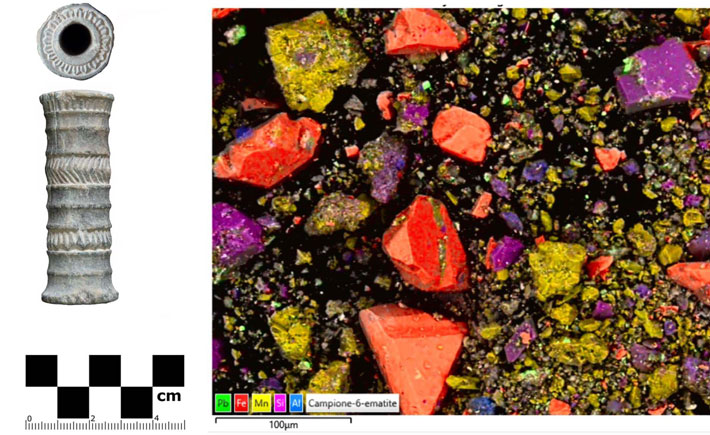 PADUA, ITALY—A small stone vial holding a bright red pigment may be an early example of lipstick, according to a Live Science report. The vial was discovered in southeastern Iran after several Bronze Age cemeteries near the city of Jiroft were flooded by the Halil River in 2001. Massimo Vidale of the University of Padua and his colleagues analyzed the artifact, which has been held at the Jiroft Archaeological Museum. Radiocarbon dating indicates that the dark, powdery substance in the vial is about 4,000 years old, Vidale said. “The container, made of a fine chloritic green rock, replicates the shape of a marsh cane segment—people, at the time, cut canes in segments to be used as cheap containers [for] everyday use,” he explained. “But in this case, the holder is made of an elegant and valuable stone,” he added. Analysis of the vial’s contents revealed that the mixture was mostly crushed hematite, which would have produced a vibrant red color. Manganite, braunite, and quartz were also identified. Vegetal fibers in the mix may have been added to scent the pigments. The concoction is thought to have been used as a lip color, similar to one depicted in an image of a young woman holding an applicator, mirror, and cylindrical vial in Egypt’s Turin Papyrus 55001, which has been dated to the twelfth century B.C., Vidale concluded. Read the original scholarly article about this research in Scientific Reports. To read about a wealthy Roman woman buried in Germany with her jewelry and makeup kit, go to "Beauty Endures."
PADUA, ITALY—A small stone vial holding a bright red pigment may be an early example of lipstick, according to a Live Science report. The vial was discovered in southeastern Iran after several Bronze Age cemeteries near the city of Jiroft were flooded by the Halil River in 2001. Massimo Vidale of the University of Padua and his colleagues analyzed the artifact, which has been held at the Jiroft Archaeological Museum. Radiocarbon dating indicates that the dark, powdery substance in the vial is about 4,000 years old, Vidale said. “The container, made of a fine chloritic green rock, replicates the shape of a marsh cane segment—people, at the time, cut canes in segments to be used as cheap containers [for] everyday use,” he explained. “But in this case, the holder is made of an elegant and valuable stone,” he added. Analysis of the vial’s contents revealed that the mixture was mostly crushed hematite, which would have produced a vibrant red color. Manganite, braunite, and quartz were also identified. Vegetal fibers in the mix may have been added to scent the pigments. The concoction is thought to have been used as a lip color, similar to one depicted in an image of a young woman holding an applicator, mirror, and cylindrical vial in Egypt’s Turin Papyrus 55001, which has been dated to the twelfth century B.C., Vidale concluded. Read the original scholarly article about this research in Scientific Reports. To read about a wealthy Roman woman buried in Germany with her jewelry and makeup kit, go to "Beauty Endures."
Possible Bronze Age Cosmetic From Iran Analyzed
